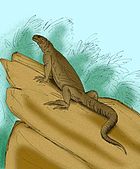
Lizards are a widespread group of squamate reptiles, with over 7,000 species, ranging across all continents except Antarctica, as well as most oceanic island chains. The group is paraphyletic since it excludes the snakes and Amphisbaenia although some lizards are more closely related to these two excluded groups than they are to other lizards. Lizards range in size from chameleons and geckos a few centimeters long to the 3-meter-long Komodo dragon.

The Lepidosauria is a subclass or superorder of reptiles, containing the orders Squamata and Rhynchocephalia. Squamata includes snakes, lizards, and amphisbaenians. Squamata contains over 9,000 species, making it by far the most species-rich and diverse order of reptiles in the present day. Rhynchocephalia was a formerly widespread and diverse group of reptiles in the Mesozoic Era. However, it is represented by only one living species: the tuatara, a superficially lizard-like reptile native to New Zealand.

Squamata is the largest order of reptiles, comprising lizards, snakes, and amphisbaenians, which are collectively known as squamates or scaled reptiles. With over 10,900 species, it is also the second-largest order of extant (living) vertebrates, after the perciform fish. Members of the order are distinguished by their skins, which bear horny scales or shields, and must periodically engage in molting. They also possess movable quadrate bones, making possible movement of the upper jaw relative to the neurocranium. This is particularly visible in snakes, which are able to open their mouths very wide to accommodate comparatively large prey. Squamates are the most variably sized living reptiles, ranging from the 16 mm (0.63 in) dwarf gecko to the 6.5 m (21 ft) Reticulated python. The now-extinct mosasaurs reached lengths over 14 m (46 ft).

Ophidia is a group of squamate reptiles including modern snakes and reptiles more closely related to snakes than to other living groups of lizards.

Rhynchocephalia is an order of lizard-like reptiles that includes only one living species, the tuatara of New Zealand. Despite its current lack of diversity, during the Mesozoic rhynchocephalians were a diverse group including a wide array of morphologically distinct forms. The oldest record of the group is dated to the Middle Triassic around 238 to 240 million years ago, and they had achieved a worldwide distribution by the Early Jurassic. Most rhynchocephalians belong to the group Sphenodontia ('wedge-teeth'). Their closest living relatives are lizards and snakes in the order Squamata, with the two orders being grouped together in the superorder Lepidosauria.

Mosasaurs comprise a group of extinct, large marine reptiles from the Late Cretaceous. Their first fossil remains were discovered in a limestone quarry at Maastricht on the Meuse in 1764. They belong to the order Squamata, which includes lizards and snakes.
Lisboasaurus is a small genus of Mesozoic crocodylomorph that lived in fresh water. It is known from fossilized tooth and jaw fragments of Late Jurassic and Early Cretaceous age. Two species have been described. In the past Lisboasaurus has been interpreted as an avialan, troodontid, or an anguimorph lizard. Both species are currently assigned to Crocodylomorpha, one is reassigned to the genus Lusitanisuchus.
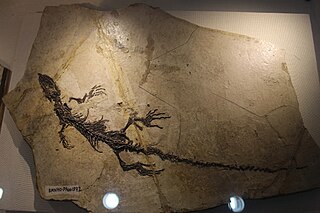
Yabeinosaurus is an extinct genus of lizard from the Early Cretaceous Jehol Group of northeastern China. The type species Yabeinosaurus tenuis is known from many well-preserved skeletons belonging to both juvenile and adult individuals. For about 60 years Yabeinosaurus was known only from juvenile specimens, leading scientists to believe that it was a small lizard with weakly developed bones. Because of this, it was thought to be closely related to geckos. Larger specimens up to 35 centimetres (14 in) snout‐vent length.

Kaganaias is an extinct genus of basal and oldest dolichosaur that lived in what is now Japan during the Early Cretaceous. Kaganaias was semi-aquatic and is the only known aquatic squamate known from before the Cenomanian stage of the Cretaceous. It is also the first to be found in an inland area, instead of on the coast where aquatic squamates are commonly found. Its generic name is derived from Kaga Province, the old name for the Ishikawa Prefecture where the specimens were found, while the species name hakusanensis comes from the mountain that gives its name to Hakusan the city near its find site. The geological formation in which the specimens were found, the Kuwajima Formation, stands alongside the Tetori River and has been the site of numerous other finds including molluscs, dinosaurs, fish, and pterosaurs.
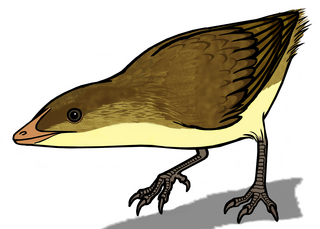
Eoalulavis is a monotypic genus of enantiornithean bird that lived during the Barremian, in the Lower Cretaceous around 125 million years ago. The only known species is Eoalulavis hoyasi.
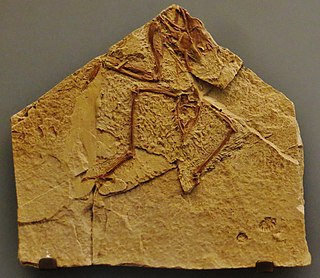
Concornis is a genus of enantiornithean birds which lived during the early Cretaceous period, in the late Barremian age about 125 million years ago. Its remains are known from the Calizas de La Huérgina Formation at Las Hoyas, Cuenca province, Spain. The single known species, Concornis lacustris, was described from the remains of one fairly complete individual skeleton.

The Anguimorpha is a suborder of squamates. The group was named by Fürbringer in 1900 to include all autarchoglossans closer to Varanus and Anguis than Scincus. These lizards, along with iguanians and snakes, constitute the proposed "venom clade" Toxicofera of all venomous reptiles.
Liushusaurus is an extinct genus of lizard described by Susan E. Evans and Yuan Wang in 2010. The genus has a single species, Liushusaurus acanthocaudata, and is known from eight fossils, several of which preserve soft tissue detail. The specimens were found in the Lower Cretaceous aged Yixian Formation of Northeast China. Liushusaurus is one of eight lizards that are known and have been named from the Yixian Formation, part of the diverse Jehol Biota ecosystem.

Reptiles arose about 320 million years ago during the Carboniferous period. Reptiles, in the traditional sense of the term, are defined as animals that have scales or scutes, lay land-based hard-shelled eggs, and possess ectothermic metabolisms. So defined, the group is paraphyletic, excluding endothermic animals like birds that are descended from early traditionally-defined reptiles. A definition in accordance with phylogenetic nomenclature, which rejects paraphyletic groups, includes birds while excluding mammals and their synapsid ancestors. So defined, Reptilia is identical to Sauropsida.
Jucaraseps is an extinct genus of small squamate lizard known from the Early Cretaceous of Las Hoyas, Spain. It contains a single species, Jucaraseps grandipes. It belonged to the clade Scincogekkonomorpha and was related to the clade Scleroglossa as well to Jurassic and Cretaceous taxa Eichstaettisaurus, Ardeosaurus, Bavarisaurus, Parviraptor, Yabeinosaurus and Sakurasaurus
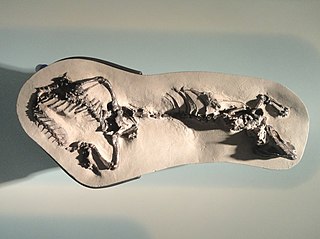
Polyglyphanodontia, also known as the Borioteiioidea, is an extinct clade of lizards from the Cretaceous that includes around a dozen genera. Polyglyphanodontians were the dominant group of lizards in North America and Asia during the Late Cretaceous. Most polyglyphanodontians are Late Cretaceous in age, though the oldest one, Kuwajimalla kagaensis, is known from the Early Cretaceous Kuwajima Formation (Japan). Early Cretaceous South American taxon Tijubina, and possibly also Olindalacerta, might also fall within Polyglyphanodontia or be closely allied to the group, but if so, they would be two of only three Gondwanan examples of an otherwise Laurasian clade. They produced a remarkable range of forms. Chamopsiids, including Chamops, were characterized by large, blunt, crushing teeth, and were most likely omnivores. Macrocephalosaurus, from the Gobi Desert, was a specialized herbivore; it grew to roughly a meter long and had multicusped, leaf-shaped teeth like those of modern iguanas. Polyglyphanodon, from the Maastrichtian of Utah, was another herbivore, but its teeth formed a series of transverse blades, similar to those of Trilophosaurus. Peneteius had remarkable, multicusped teeth, similar to those of mammals. The polyglyphanodontids first appear in the latter part of the Early Cretaceous in North America, and became extinct during the Cretaceous-Paleogene extinction event. Polyglyphanodontians closely resembled the teiid lizards, and purported teiid lizards from the Late Cretaceous appear to be polyglyphanodontians. The only species known to have survived the Cretaceous was Chamops, which survived until the very early Ypresian.
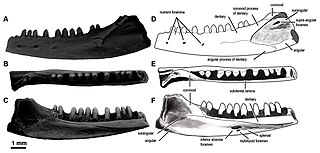
Paramacellodidae is an extinct family of lizards that first appeared in the Middle Jurassic around 170 million years ago (Ma) and became extinct at the end of the Cretaceous around 66 Ma. It was one of the earliest groups of lizards to have undergone an evolutionary radiation, with members found across the supercontinent Laurasia. The phylogenetic relationships and constituent species of Paramacellodidae are uncertain. Many studies regard them to be scincomorphs, a large group that includes skinks and their closest extinct relatives, and possibly also to Cordyoidea, a group that includes spinytail lizards and relatives. Like modern skinks, paramacelloidids had rectangular bony plates called osteoderms covering most of their bodies, including their backs, undersides, and tails. They also had short and robust limbs. Paramacellodids are distinguished from other lizards by the combination two traits in their dentition, the teeth are labiolingually expanded at their bases, and the tooth apices are lingually concave.

Eichstaettisaurus is a genus of lizards from the Late Jurassic and Early Cretaceous of Germany, Spain, and Italy. With a flattened head, forward-oriented and partially symmetrical feet, and tall claws, Eichstaettisaurus bore many adaptations to a climbing lifestyle approaching those of geckoes. The type species, E. schroederi, is among the oldest and most complete members of the Squamata, being known by one specimen originating from the Tithonian-aged Solnhofen Limestone of Germany. A second species, E. gouldi, was described from another skeleton found in the Matese Mountains of Italy. Despite being very similar to E. schroederi, it lived much later, during the Albian stage. Fossils of both species show exceptional preservation due to deposition in low-oxygen marine environments.
Oardasaurus is an extinct genus of lizard from the latest Cretaceous of Romania. It is a member of the Barbatteiidae, a group of lizards closely related to the Teiidae. At 20 centimetres (7.9 in) in length, it was much smaller than the only other named member of the Barbatteiidae, Barbatteius, which lived slightly later. Like Barbatteius, Oardasaurus can be identified by the presence of a crust of bone deposits, or osteoderms, on the roof of its skull; it differs from Barbatteius in the pattern of the sculpturing on this crust. Both Oardasaurus and Barbatteius lived in the isolated island ecosystem of Hațeg Island, having rapidly diversified into various generalist predators of small prey after their arrival on the island during the Early Cretaceous. They went extinct in the Cretaceous–Paleogene extinction event.

Dolichosauridae is a family of Cretaceous aquatic ophidiomorphan lizards closely related to the snakes and mosasaurs.
















